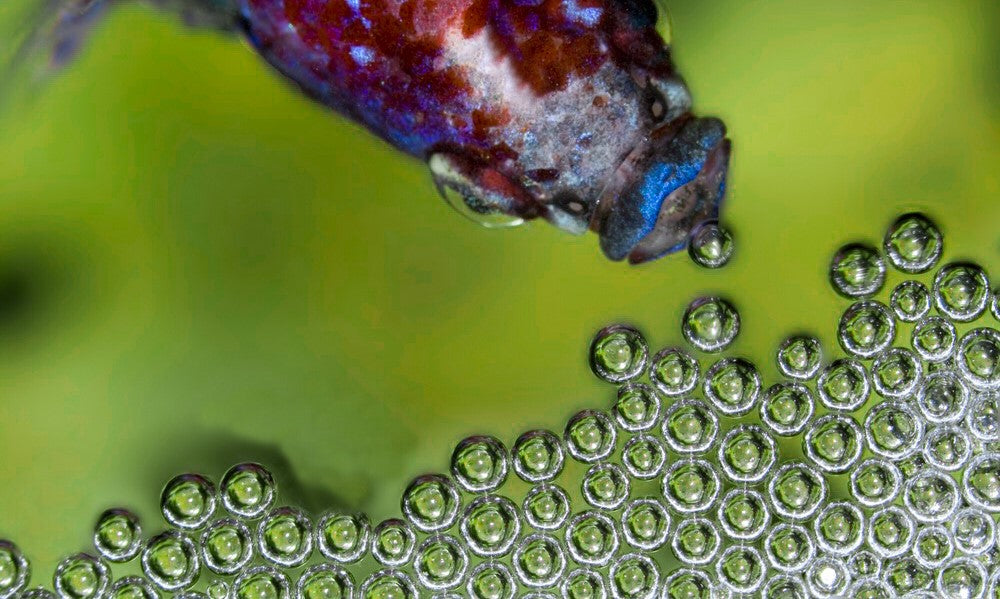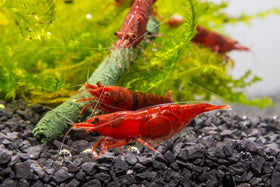
Why Do Bettas Make Bubble Nests?
Written by: Tammy (@aquarist_tl) and Team Buce Plant
Have you ever seen a collection of bubbles laying on the surface of the water in a betta tank? That cluster of bubbles is known as a bubble nest! Blowing these hoards of bubbles is part of a betta fish’s breeding process.
In this blog post, we will do a deep dive into the finer details of bubble nests as well as how and why they are made. In this article, we'll cover the following topics:
1. What is a bubble nest?
2. How are bubble nests created?
3. Why do bettas make bubble nests?
4. Does a bubble nest mean my betta is happy?
5. How do I perform water changes without destroying a bubble nest?
6. More about keeping a betta happy
What is a bubble nest?
As mentioned previously, a bubble nest is a mass of bubbles created by numerous species of fish, like Gouramis and Bettas, with the intent to reproduce. These types of fish take in gulps of air from the surface of the water and proceed to slowly build these nests, one bubble at a time.
Bubble nests can usually be found against the walls of the tank or under a floating object, such as a leaf. These objects help preserve the nest and protect the bubbles from bursting or spreading apart. Bubble nests can easily break when disturbed. Any movement in the water or wind blowing across the tank can cause all or most of the bubbles to pop or disperse.

How are bubble nests created?
To explain how bettas create their bubble nests, we must first discuss how they are "Labyrinth" fish (one of the few types of fish that can build bubble nests.) All species of labyrinth fish are found under the Anabantoidae family, originating from areas in Southeast Asia and Africa. Common types of Anabantoidae we see in the fishkeeping hobby are Bettas, Gouramis, and Paradise fish.
Betta fish have an organ called the "labyrinth," which allows them to take in air from the surface of the water. When these fish breathe air, oxygen passes through a membrane of the labyrinth. As blood circulates through this organ, it absorbs the oxygen and then provides the rest of the body with it.
The reason bettas need this organ is due to the conditions of the environment they are found in, which are very hot temperatures, still water, shallow water, or a combination of any of these conditions. These factors cause a depletion of available oxygen in the water, so bettas resort to acquiring it through the air. They will always need access to the surface of the water in order to survive.
Since bettas are able to breathe in air, they are able to utilize this ability to blow bubbles using their saliva. When building betta nesting bubbles, the betta fish first finds a spot they deem safe from both predators and water movement.
In our aquariums, this spot is usually in a corner or against the glass of the tank. In the wild, they typically build it under floating debris like leaves. Once the fish finds a suitable place to make the nest, they use their saliva to blow bubbles one by one until a decent collection of bubbles is formed.
- Note: Tannins are a type of acid caused by broken down leaves or driftwood that benefits betta fishes' health and stress levels. Betta fish are known to come from humid areas where the water is heavy with tannins. The added stickiness from the tannins and humidity actually helps keep the nest from breaking apart.

Why do bettas make bubble nests?
Creating bubble nests is a natural behavior for a mature betta fish. Ultimately, bubble nests play an important role in the betta fish reproduction process.
Most of the time, males of the species are the ones who will create betta bubble nests when they are ready to mate. After female betta fish lays eggs, males will be the ones to protect the eggs and fry during the breeding process. However, aquarium keepers have reported many cases where females have created bubble nests themselves.
When a male betta fish courts a female and is able to squeeze the eggs out of her, he then takes the eggs into his mouth and places them into the nest. Each egg gets its own bubble. He’ll then guard the eggs and fan them to prevent any fungus growth that could kill the eggs. Once they hatch, he will watch over the fry until they are old enough to fend for themselves.
Surprisingly, labyrinth fish fry are not born with the labyrinth organ; it slowly develops as the fry ages. This means that these small fish have a chance of dying from insufficient oxygen. Because the amount of dissolved oxygen is highest at the surface of the water, keeping the fry in the bubble nest increases their chances of survival. It is also typically cleaner within the bubble nest, as the bottom of its environment has a higher chance of being full of debris.

Does a bubble nest mean my betta is happy?
Although a bubble nest is a good sign that your betta is happy and healthy, it is usually the case that your betta is simply ready to reproduce. In fact, if your betta is building a bubble nest, it does not necessarily mean it is happy. Betta fish, for example, are probably not happy living in the small cups that are typically sold in big box pet stores. However, some have been known to still make nests under these conditions.
There are also cases of the opposite, where a betta is in a tank of ideal size with pristine water conditions, plenty of aquatic plants, and hiding spots among hardscape, but will never form a bubble nest. So do not be discouraged if your pet fish hasn’t been making any nests! There are a many instances where some fish almost never produce a nest. In situations like these, breeders will actually transfer another fish’s bubble nest over to the one they want to breed.

How do I perform water changes without destroying a bubble nest?
One of the most important parts of keeping a tank with aquarium plants, especially one with a betta in it, is water changes! That being said, you should never forego your regular tank maintenance for the sake of preserving your betta's nest.
Unless you're trying to breed bettas, it's okay if you end up accidentally ruining the bubbles. Although some bettas are known to get upset, and even flare when they have realized their hard word is disrupted, your betta is capable of quickly blowing more bubbles and rebuilding the nest if they want to.
However, if you would prefer to not disrupt your betta's nest-making, or if seeing eggs in the nest and would like some baby bettas, there are ways around accidentally breaking up the nest.
Here are 2 options to prevent ruining your betta's bubble nest when doing aquarium maintenance:
-
1. Use airline tubing
f you're careful, doing slow water changes can be done easily with airline tubing so long as you stay on the opposite side of the tank from the bubble nest. A smaller tube will lower the chances of your siphon disturbing the nest at the water's surface. Then, once the eggs hatch, you can freely do maintenance on the entire tank as normal.
-
2. Remove the nest
An easy method to preserve the nest is removing the nest prior to performing a water change and then replacing it once you're done. You can do this by using a plastic cup to scoop up the nest. Then, once you're ready, carefully sink the cup back in to put the nest back.

Keeping Your Betta Happy
As we mentioned before, seeing a bubble nest in your aquarium can be a good sign. However, it's always important to keep up with consistent water changes, test your water parameters, and monitor your betta's behavior to ensure your betta's good health. As fishkeepers, we always want our aquatic pets comfortable in the homes we provide for them. To learn more about proper betta fish care, click the articles below:
Tell us - Was this article helpful? Please leave a comment below!
If you have any questions regarding this article, please DM us on Instagram, Facebook, or email support@buceplant.com so we can assist you - @buceplant





Comments
Leave a comment